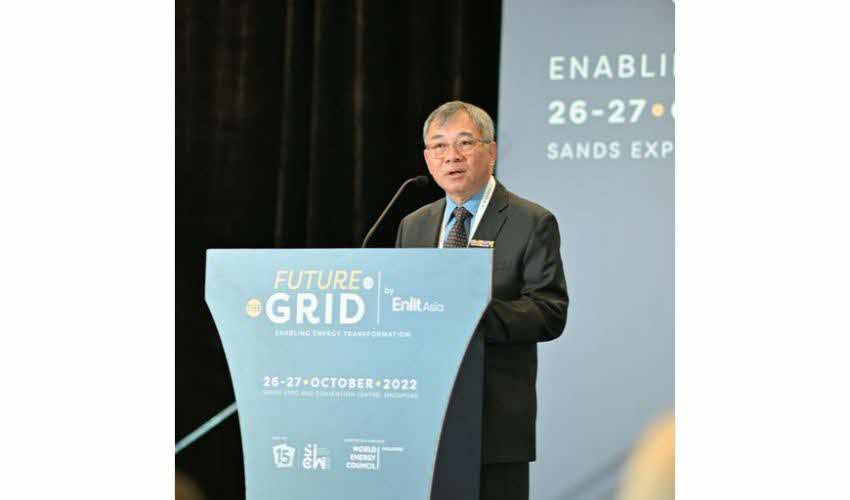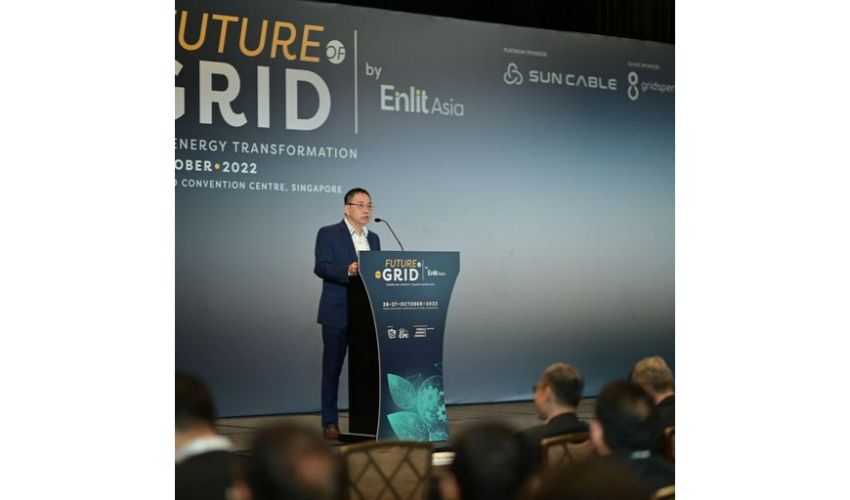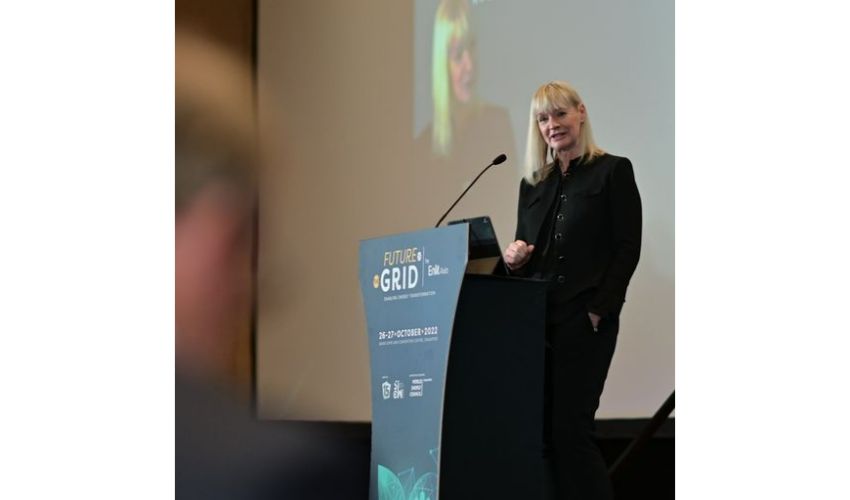Innovative advancement, increased digitalisation, how to develop the energy metaverse and what's needed to humanise the energy system are some takeaways from keynote speakers at Future of the Grid. Alexis Loy reports.

As the energy trilemma of energy security, affordability and sustainability have become urgent key considerations that would affect the energy transition, the current grid will need to be enhanced now to facilitate the grid of the future. This point was made by Richard Lim, Chairman of the Energy Market Authority (EMA) in his Keynote Address at Future of the Grid.
The two-day event, held on 26 October in conjunction with SIEW 2022, gathered senior energy experts to discuss the challenges, policies and strategies needed to transform the grid for the future.
Mr Lim shared that there is a need to strengthen the grid and its connectivity to enable multilateral electricity trade, while sharing our decarbonisation goals and tapping on the abundance of renewable energy within the ASEAN region.
These interconnected grids in ASEAN will help drive investments in low carbon projects, open new markets and strengthen energy adequacy and resilience. Such grids can also bring down system costs, allowing for an integrated energy supply by minimising duplication of energy and non-energy services.
With regional grid connectivity in place, Mr Lim said this can enhance mutual support through flexible sharing of resources, to which Singapore has been strengthening the regional grid architecture.
He cited the inter-regional grid between four ASEAN nations (Laos PDR, Thailand, Malaysia, and Singapore) known as the Laos-PDR-Thailand-Malaysia-Singapore Power Integration Project or LTMS-PIP. This project is a step towards realising the broader ASEAN Power Grid vision. He highlighted that Singapore plans to import up to 4 GW of electricity by 2035.
Grids as highly inter-connected networks of decentralised systems
Mr Lim envisaged that grids would become highly inter-connected networks of decentralised systems. Here, larger end-users can use the micro-grids to enhance energy resiliency and reap cost savings from energy optimisation, while unlocking revenue streams through participation in demand response programmes.
System operators would, however, need to manage the rising number of energy resources and increased demand. They will also have to develop multi-layered communication systems to effectively manage the distributed resources and mitigate the impacts of such distributed energy resources (DER) on the overall network reliability.
Here, Artificial Intelligence (AI) and Machine Learning (ML) can facilitate the monitoring of demand and supply. In turn, this would also minimise cost of infrastructure and capacity, he added.
Future Grid – more resilient and intelligent
Mr Lim envisioned how grids will acquire intelligence enabled by digital technology, although this will require new investments in the grid industry. He cited how EMA is working with Singapore Power (SP Group) to develop a digital twin for the power grid. This would help enhance the robustness of the grid system, which would aid in planning by allowing planners to explore different scenarios and enabling them to make smarter decisions and investment choices.
The digital twin would consist of both the network twin and asset twin, which can identify any potential risks in the network and assets to facilitate maintenance and renewal works. He sees this as enabling better network and resource utilisations. This will help to enable deployment of more electric vehicle charging points and solar photovoltaic panels to handle a more complex grid system with minimal human intervention.
Energy 50 Committee (E50C) course development
The E50C has, in its Report, charted the course for a more resilient grid of the future. Firstly, this is to build a multi-layered grid leveraging on advanced communications systems while harnessing on distributed energy resources to enhance grid efficiency. Secondly, AI and ML with high data security should be leveraged to deliver an intelligent grid.
He believes Singapore can be a frontrunner of the future intelligent grid. This will help boost the country's economy and address any short-term demand surges arising from integrating solar energy to the grid. This can be made possible by learning from weather and demand consumption patterns; in turn, enabling the electricity window to be reduced from 30 minutes to just 5 minutes, thus maximising cost savings.
Mr Lim concluded by saying that Singaporeans enjoy a high-level of electricity reliability. In the pursuit of cleaner energy, Singapore will continue to leverage on technology to facilitate grid planning and investments for the long term.
Keynote Address by SP PowerGrid Limited's CEO Jimmy Khoo
The event also saw Mr Khoo of SP PowerGrid Limited (SP) outline how to build the foundations for the energy metaverse. He presented six steps needed to develop this energy metaverse, which would involve a digital twin and enhancing capabilities.

Steps 1 and 2: Incubate a twin and conjoining the twins
Mr Khoo shared that this will involve developing inventory dashboards to monitor the network and asset in real-time. Next would be to connect the twin to the conditions of the real world. For this, he presented how SP has been able to use QR codes to enhance the company's existing applications for operation and maintenance, while highlighting possible hazards on devices.
Steps 3 and 4: Enable pervasive sensing and seed a low-cost network
After conjoining the digital twin to its real-world counterpart, Mr Khoo cautioned about the high cost involved in enabling pervasive sensing. To address this high cost, Mr Khoo cited how SP is working with the Nanyang Technological University to develop condition-monitoring systems, with the target to reduce costs by five times.
On seeding a low-cost network, he shared how SP is collaborating with Agency for Science, Technology and Research (A*STAR) to explore the use of TV spectrums with TV-wide spaces. This would provide the advantages of non-line-of-sight transmission and broadband data bandwidth.
Steps 5 and 6: Experiment with sense-making and build capabilities
Mr Khoo highlighted that the problem may not be fully appreciated as more information does not translate to greater understanding of the issue. In addition, the solutions may be fragmented. In order to manage these challenges, he showed how integrating both cognition and sense-making can help to make the right decisions. He showed how SP is setting up a cognition test-bed to investigate what information is needed for the problem, how to present the information, and who to do the work processes.
On the last step, he said all the steps would not be possible without building the necessary capabilities among SP's workforce. The company's data scientists are developing a digital architecture for this energy metaverse and have provided employees with mobile devices to drive innovation and build a digital culture.
SP's CEO concluded by reiterating that the journey for energy transition would be long and challenging, but that there are many things we can do to prepare ourselves for future uncertainties.
Keynote Address by World Energy Council's Secretary General & CEO Dr Angela Wilkinson
Dr Wilkinson of the World Energy Council (WEC) recounted how the global forum was created at a time of the energy crisis and Ukraine-Russian war to rebuild the energy system, and how Asian countries have been among WEC's founding members. She presented on how the World Energy Council has facilitated the sharing of invaluable insights and expertise among its member countries, as well as established collaborations.

“Today, the world presents a new energy. An era of energy for people and planet,” she said, pointing to how the technology transition always involves societal transformation and disruption. Coupled with the pandemic and world conflicts, this has triggered an energy crisis with global energy shortages which would lead to higher costs of living. In view of global tensions, the need to be prepared for energy shocks has become more urgent in order to manage price increases and extreme weather conditions.
World Energy Council’s surveys and energy monitors
Dr Wilkinson shared how WEC’s World Energy Pulse surveys and World Energy Issues Monitor have helped various countries’ leaders to lead and learn from each other. She highlighted how the World Energy Monitor in 2022 indicated a 12-fold increase in volatilities compared with 2021, with commodities prices and geopolitical conditions as priorities. By April 2022, World Energy Pulse surveys had shown that energy leaders were reconnecting with energy security and climate goals, lending some confidence to the global energy transition.
However, by August 2022, Dr Wilkinson shared that the World Energy Pulse survey indicated a great shift in sentiments as more leaders expressed concerns that energy security issues would dampen the pace for a clean energy transition. She elaborated that this could be due to a lack of trust, transparency and scepticism.
Through all these, there is the need for a stronger and flexible grid to address future uncertainties as more parts are connected to the grid. She stated that the grid's resilience should extend beyond people and assets.
Dr Wilkinson called on increased demands to decarbonise energy uses and accelerate decarbonisation without destabilising communities. This can be done by engaging diverse communities and rapidly deploying new approaches and practices to drive clean energy projects. Here, she cited projects in Taiwan (solar initiatives) and Malaysia (better electricity connection to remote communities).
In conclusion, Dr Wilkinson believes we can do more together by collaborating on energy transition projects, and humanising the energy system to restore energy between humans and our planet.
Follow us on Twitter (@SIEW_sg) to get the latest #SIEW2022 updates throughout the day!